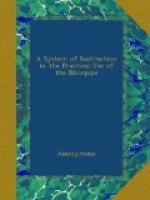Carbonate of soda does not affect it in the oxidation flame, but in the reduction flame and upon charcoal, it is absorbed and reduced, and remains, after washing off the carbon, as a white metallic powder, which is infusible, and has a greater attraction for the magnet than iron.
Sesquioxide of Nickel (Ni^{2}O^{3}).—It is in the form of a black powder, and does not combine with other substances, unless it is reduced to the protoxide. It exhibits before the blowpipe the same behavior as the protoxide.
GROUP SIXTH.—ZINC, CADMIUM, ANTIMONY, TELLURIUM.
The substances of this group can be reduced upon charcoal by fusion with carbonate of soda, but the reduced metals are volatilized, and cover the charcoal with sublimates.
(a.) Zinc (Zn).—This metal is found in considerable abundance, but never occurs in the pure metallic state, but in combination with other substances, chiefly as sulphide in zinc blende, as carbonate in calamine, and as the silicate in the kieselzinc ore; also, with sulphuric acid, the “vitriol of zinc.”
Zinc is of a bluish-white color and metallic lustre, is crystalline and brittle when heated 400 deg.F., but malleable and ductile between 200 deg. and 300 deg.. It will not oxidize in dry air, but tarnishes if exposed to air containing moisture, first becomes grey, and then passes into the white carbonate. It decomposes in water at a glowing heat. It is dissolved by diluted acids, while hydrogen is eliminated. It melts at about 775 deg., and distills when exposed to a white heat in a close vessel. When heated over 1000 deg. in the open air, it takes fire, and burns with a bluish-white light, and with a thick white smoke of oxide of zinc.
Oxide of Zinc (ZnO).—In the pure state, oxide of zinc is a white powder, infusible, and not volatile. It is readily soluble in acids after being heated strongly. Its soluble neutral salts, when dissolved in water, change blue litmus paper to red. Its salts, with organic acids, are decomposed by ignition, and the carbonate of zinc remains.
The oxide of zinc turns yellow by being ignited in the oxidation flame, but it is only visible by daylight; this color changes to white when cold. It does not melt, but produces a strong light, and it is not volatile.
It disappears gradually in the flame of reduction, while a white smoke sublimates upon the charcoal. This sublimate is yellow while hot, but changes to white when cold. The cause of this is, that the oxide is reduced, is volatilized, and re-oxidized, by going through the external flame in the form of a metallic vapor.
Borax dissolves oxide of zinc in the flame of oxidation easily to a clear bead, which is yellow while hot, and colorless when cold. The bead becomes, by the addition of more oxide, enamelled, while cooling. If the bead is heated with the intermittent flame, it is milk-white when cold. When heated in the flame of reduction upon platinum wire, the bead at first appears opaque, and of a greyish color, but becomes clear again after a continued blast.




